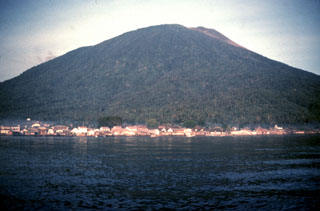Report on Gamalama (Indonesia) — 15 July-21 July 2015
Smithsonian Institution / US Geological Survey
Weekly Volcanic Activity Report, 15 July-21 July 2015
Managing Editor: Sally Sennert.
Please cite this report as:
Global Volcanism Program, 2015. Report on Gamalama (Indonesia) (Sennert, S, ed.). Weekly Volcanic Activity Report, 15 July-21 July 2015. Smithsonian Institution and US Geological Survey.
Gamalama
Indonesia
0.81°N, 127.3322°E; summit elev. 1714 m
All times are local (unless otherwise noted)
BNPB reported that a phreatic explosion at Gamalama on 16 July generated a gray-and-white plume that rose as high as 1.5 km above the crater and drifted N. The Alert Level remained at 2 (on a scale of 1-4); visitors and residents were warned not to approach the crater within a radius of 1.5 km. The Sultan Babullah International airport in Ternate was closed on 18 July. Several explosions during 18-19 July produced white-and-gray plumes that rose 300-800 m and drifted NW. A preliminary count of refugees showed there were 1,505 people (450 families) displaced by the eruption. Ash deposits were 1.5-6 mm thick in northwestern villages.
Based on pilot reports, ground-based observations, wind data, PVMBG reports, and satellite images, the Darwin VAAC reported that during 16-20 July ash plumes rose to altitudes of 2.1-5.5 km (7,000-18,000 ft) a.s.l. and drifted 20-130 km NE, NW, W, and SW.
Geological Summary. Gamalama is a near-conical stratovolcano that comprises the entire island of Ternate off the western coast of Halmahera, and is one of Indonesia's most active volcanoes. The island was a major regional center in the Portuguese and Dutch spice trade for several centuries, which contributed to the extensive documentation of activity. Three cones, progressively younger to the north, form the summit. Several maars and vents define a rift zone, parallel to the Halmahera island arc, that cuts the volcano; the S-flank Ngade maar formed after about 14,500–13,000 cal. BP (Faral et al., 2022). Eruptions, recorded frequently since the 16th century, typically originated from the summit craters, although flank eruptions have occurred in 1763, 1770, 1775, and 1962-63.
Sources: Badan Nacional Penanggulangan Bencana (BNPB), Darwin Volcanic Ash Advisory Centre (VAAC)

